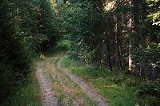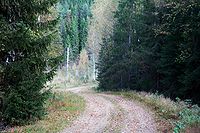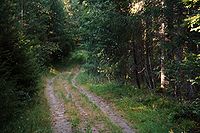
Carl Fredriksens Transport
Encyclopedia

Code name
A code name or cryptonym is a word or name used clandestinely to refer to another name or word. Code names are often used for military purposes, or in espionage...
for an operation during the occupation of Norway by Nazi Germany
Occupation of Norway by Nazi Germany
The occupation of Norway by Nazi Germany started with the German invasion of Norway on April 9, 1940, and ended on May 8, 1945, after the capitulation of German forces in Europe. Throughout this period, Norway was continuously occupied by the Wehrmacht...
to help Jews and other persecuted Norwegians escape persecution
Holocaust in Norway
In the middle of the occupation of Norway by Nazi Germany, there were at least 2,173 Jews in Norway. At least 775 of these were arrested, detained, and/or deported. 742 were murdered in the camps, 23 died as a result of extrajudicial execution, murder, and suicide during the war; bringing the total...
, deportation
Jewish deportees from Norway during World War II
During the Nazi occupation of Norway, German authorities deported about 768 individuals of Jewish background to concentration camps outside of Norway. 28 of these survived World War Two.-Deportation:The deportation schedule for the major transports was:...
, and murder in death camps.
Background
The Nazi regime in Norway implemented its part of the Holocaust through a series of steps, starting with registration, then confiscation, internment and concentration, and ultimately deportation of Jews, primarily to Auschwitz. Some Jews had fled Norway to Sweden earlier in the war, but most had stayed in their homes until October 26, 1942. At that point, most men were arrested and detained in prison camps, while women and children were ordered to report to the nearest police station on a daily basis.The escape operation
Although the Norwegian resistance movementNorwegian resistance movement
The Norwegian resistance to the occupation of Norway by Nazi Germany began after Operation Weserübung in 1940 and ended in 1945. It took several forms:...
had maintained a network of escape routes to Sweden, they were unprepared to deal with the urgent plight of Jews who faced deportation. In addition, simultaneously with the arrest and deportation of Jews in 1942, the Gestapo
Gestapo
The Gestapo was the official secret police of Nazi Germany. Beginning on 20 April 1934, it was under the administration of the SS leader Heinrich Himmler in his position as Chief of German Police...
launched an offensive to identify and apprehend members of the Norwegian resistance. This put pressure both on the viability and capacity of existing escape routes.
Carl Fredriksens Transport (named after Norway's King Haakon VII who's real name was Christian Frederik Carl Georg Valdemar Axel) came into being when four Jewish Norwegians appeared on the doorstep of nursery
Nursery (horticulture)
A nursery is a place where plants are propagated and grown to usable size. They include retail nurseries which sell to the general public, wholesale nurseries which sell only to businesses such as other nurseries and to commercial gardeners, and private nurseries which supply the needs of...
owner Rolf A. Syversen, asking for help. Through one of the leaders of Milorg
Milorg
Milorg was the main Norwegian resistance movement in World War II....
, Ole Berg
Ole Berg
Ole Berg was a Norwegian military officer. He participated in the defence during the German invasion of Norway in 1940.He built up the Norwegian police forces in Sweden from 1943 to 1945. He served as Chief of Defence of Norway from 1946 to 1955.In 1947 he was awarded the title of Commander with...
, Syversen contacted Alf Tollef Pettersen, who had been fired from the Norwegian police force for refusing to pledge loyalty to the Quisling
Quisling
Quisling is a term used in reference to fascist and collaborationist political parties and military and paramilitary forces in occupied Allied countries which collaborated with Axis occupiers in World War II, as well as for their members and other collaborators.- Etymology :The term was coined by...
regime. Pettersen had been hired to manage transportation and was intimately familiar with the roads from Oslo to the border to Sweden through Østfold
Østfold
is a county in southeastern Norway, bordering Akershus and southwestern Sweden , while Buskerud and Vestfold is on the other side of the bay. The seat of the county administration is Sarpsborg, and Fredrikstad is the largest city.Many manufacturing facilities are situated here. Moss and...
.
What started with a few nighttime drives turned into a large-scale operation. The group accepted all refugees, but charged those who could afford it 180 kroner
Norwegian krone
The krone is the currency of Norway and its dependent territories. The plural form is kroner . It is subdivided into 100 øre. The ISO 4217 code is NOK, although the common local abbreviation is kr. The name translates into English as "crown"...
. In time, the Norwegian resistance group Sivorg put its clandestine network and financial resources behind it. Pettersen, his wife Gerd, Syversen, and the resistance leader Reidar Larsen managed the operation. Altogether about 1,000 refugees were moved to safety, of whom approximately 500 were Jewish. The name Carl Fredriksens Transport was based on the original name of the exiled Norwegian king Haakon VII
Haakon VII
Haakon VII may refer to:People* Haakon VII of Norway , King of Norway Ships* HNoMS King Haakon VII, a Royal Norwegian Navy escort ship in commission from 1942 to 1951...
, who was Carl, son of Fredrik
Frederick VIII of Denmark
Frederick VIII was King of Denmark from 1906 to 1912.-Early life:Frederick was born on 3 June 1843 in the Yellow Palace in Copenhagen as Prince Frederick of Schleswig-Holstein-Sonderburg-Glücksburg, a junior male line of the House of Oldenburg descended from Christian III of Denmark and who had...
, but also sounded like a common Norwegian name.
After having found their way to Syversen's nursery near Carl Berners plass
Carl Berners plass
Carl Berners plass is a square in Oslo, Norway. It is located in the borough Grünerløkka, south of Sinsen. The Sinsen Line of the Oslo Tramway runs over the square. The colloquial expression for the square is just "Carl Berner". Around the square is a large number of shops as well as inexpensive...
in Oslo, refugees were loaded on the backs of trucks, and covered by a tarp
Tarpaulin
A tarpaulin, colloquially tarp, is a large sheet of strong, flexible, water-resistant or waterproof material, often cloth such as canvas or polyester coated with urethane, or made of plastics such as polyethylene. In some places such as Australia, and in military slang, a tarp may be known as a...
. Children were often sedated. Gerd Pettersen forged bills of lading and other necessary documents. Sivorg's network along the route would monitor German or border police patrols.

The operation started in late November 1942. About ten truckloads a week went to the border and back in the dark of night, mostly with headlights off. By mid-January, the network had been infiltrated by Norwegian collaborators and had to be shut down. The Pettersens made a successful dash for the border in a sedan, breaking the axle just as they crossed into Sweden. Rolf Syversen stayed in Oslo, but was arrested for an unrelated matter in June. He was executed at Trandumskogen
Trandumskogen
Trandumskogen is a forest located in Ullensaker, Akershus county, Norway. It was the site of one of the first discoveries in May 1945 of German mass graves in Norway. The German executioner Oskar Hans was the officer in command of the unit performing the executions.In total 173 Norwegians, 6...
in November 1944.
Commemoration
Although this was the largest rescue operation in Norway during World War II, it was virtually unknown for decades. In order to maintain operational security, the refugees were not aware that they were part of a larger scheme, and their rescuers' identities were kept secret in any event. Ragnar UlsteinRagnar Ulstein
-Early life and World War II:Ulstein was born in Ulstein, Sunnmøre, as the son of Johannes Olsson Ulstein and Borghild Strand . He finished his secondary education at Volda in June 1940. Later that year he fled to the United Kingdom due to World War II and the German occupation of Norway...
, a historian who specialized in the stream of refugees from Norway to Sweden, uncovered the most important features during an interview with Alf Tollef Pettersen. Oslo Jewish Museum has continued the research started by Ulstein and interviewed Gerd Pettersen before she died.
In September of 2010, a commemorative plaque and cast-iron truck were unveiled at the turn-off to the private road that went to the Swedish border. Filmmaker Robert Murphree is working to create a movie about the operation, historian Mats Tangestuen at Oslo Jewish Museum is writing a book, and artist Victor Lind is creating a public space at the site of Syversen's nursery he is calling "This is a Good Place" (Dette er et fint sted).
A bicycle ride, named after the operation, takes place in mid-August from Fetsund
Fetsund
Fetsund forms the center of the municipality Fet in the county of Akershus, Norway. The name comes from the way the area is, and Fet means "where water meets grass". As for the -sund part, it simply means 'strait, inlet'...
, along the original route and to the border crossing to Sweden. The Pettersen's granddaughter Ane Munkeby arranges the ride.

